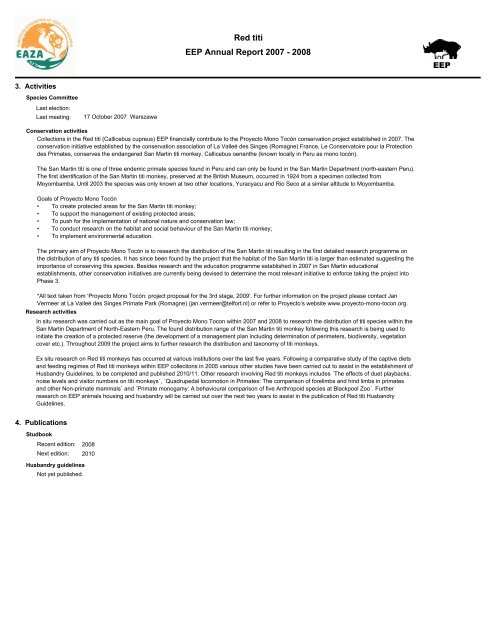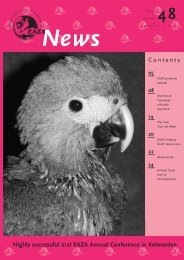EAZA Yearbook 2007/2008 - European Association of Zoos and ...
EAZA Yearbook 2007/2008 - European Association of Zoos and ...
EAZA Yearbook 2007/2008 - European Association of Zoos and ...
You also want an ePaper? Increase the reach of your titles
YUMPU automatically turns print PDFs into web optimized ePapers that Google loves.
3. Activities<br />
Species Committee<br />
Last election:<br />
Last meeting:<br />
17 October <strong>2007</strong> Warszawa<br />
Red titi<br />
EEP Annual Report <strong>2007</strong> - <strong>2008</strong><br />
Conservation activities<br />
Collections in the Red titi (Callicebus cupreus) EEP financially contribute to the Proyecto Mono Tocón conservation project established in <strong>2007</strong>. The<br />
conservation initiative established by the conservation association <strong>of</strong> La Valleé des Singes (Romagne) France, Le Conservatoire pour la Protection<br />
des Primates, conserves the endangered San Martin titi monkey, Callicebus oenanthe (known locally in Peru as mono tocón).<br />
The San Martin titi is one <strong>of</strong> three endemic primate species found in Peru <strong>and</strong> can only be found in the San Martin Department (north-eastern Peru).<br />
The first identification <strong>of</strong> the San Martin titi monkey, preserved at the British Museum, occurred in 1924 from a specimen collected from<br />
Moyombamba. Until 2003 the species was only known at two other locations, Yuracyacu <strong>and</strong> Rio Seco at a similar altitude to Moyombamba.<br />
Goals <strong>of</strong> Proyecto Mono Tocón<br />
• To create protected areas for the San Martin titi monkey;<br />
• To support the management <strong>of</strong> existing protected areas;<br />
• To push for the implementation <strong>of</strong> national nature <strong>and</strong> conservation law;<br />
• To conduct research on the habitat <strong>and</strong> social behaviour <strong>of</strong> the San Martin titi monkey;<br />
• To implement environmental education.<br />
The primary aim <strong>of</strong> Proyecto Mono Tocón is to research the distribution <strong>of</strong> the San Martin titi resulting in the first detailed research programme on<br />
the distribution <strong>of</strong> any titi species. It has since been found by the project that the habitat <strong>of</strong> the San Martin titi is larger than estimated suggesting the<br />
importance <strong>of</strong> conserving this species. Besides research <strong>and</strong> the education programme established in <strong>2007</strong> in San Martin educational<br />
establishments, other conservation initiatives are currently being devised to determine the most relevant initiative to enforce taking the project into<br />
Phase 3.<br />
*All text taken from ‘Proyecto Mono Tocón: project proposal for the 3rd stage, 2009’. For further information on the project please contact Jan<br />
Vermeer at La Valleé des Singes Primate Park (Romagne) (jan.vermeer@telfort.nl) or refer to Proyecto’s website www.proyecto-mono-tocon.org.<br />
Research activities<br />
In situ research was carried out as the main goal <strong>of</strong> Proyecto Mono Tocon within <strong>2007</strong> <strong>and</strong> <strong>2008</strong> to research the distribution <strong>of</strong> titi species within the<br />
San Martin Department <strong>of</strong> North-Eastern Peru. The found distribution range <strong>of</strong> the San Martin titi monkey following this research is being used to<br />
initiate the creation <strong>of</strong> a protected reserve (the development <strong>of</strong> a management plan including determination <strong>of</strong> perimeters, biodiversity, vegetation<br />
cover etc.). Throughout 2009 the project aims to further research the distribution <strong>and</strong> taxonomy <strong>of</strong> titi monkeys.<br />
Ex situ research on Red titi monkeys has occurred at various institutions over the last five years. Following a comparative study <strong>of</strong> the captive diets<br />
<strong>and</strong> feeding regimes <strong>of</strong> Red titi monkeys within EEP collections in 2005 various other studies have been carried out to assist in the establishment <strong>of</strong><br />
Husb<strong>and</strong>ry Guidelines, to be completed <strong>and</strong> published 2010/11. Other research involving Red titi monkeys includes ´The effects <strong>of</strong> duet playbacks,<br />
noise levels <strong>and</strong> visitor numbers on titi monkeys´, ´Quadrupedal locomotion in Primates: The comparison <strong>of</strong> forelimbs <strong>and</strong> hind limbs in primates<br />
<strong>and</strong> other Non-primate mammals´ <strong>and</strong> ´Primate monogamy: A behavioural comparison <strong>of</strong> five Anthropoid species at Blackpool Zoo´. Further<br />
research on EEP animals housing <strong>and</strong> husb<strong>and</strong>ry will be carried out over the next two years to assist in the publication <strong>of</strong> Red titi Husb<strong>and</strong>ry<br />
Guidelines.<br />
4. Publications<br />
Studbook<br />
Recent edition:<br />
<strong>2008</strong><br />
Next edition: 2010<br />
Husb<strong>and</strong>ry guidelines<br />
Not yet published.<br />
EEP
















